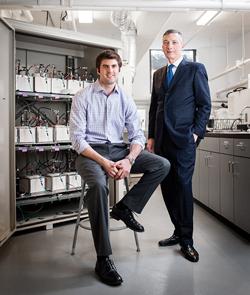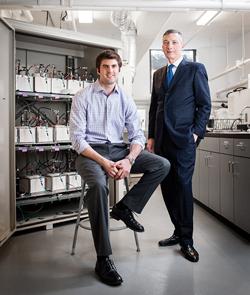Startup Devises Liquid Metal Batteries for the Electricity Grid
February 26, 2013

A Boston-area startup has invented new liquid-based heavy-duty battery technology that its founders hope will be the foundation of the next-generation electricity grid in which alternative energy will play a key role. Ambri -- yet another company formed out of that bastion of modern invention, the Massachusetts Institute of Technology (MIT) -- is developing giant cells that are comprised of liquid electrodes and an electrolyte capable of storing large amounts of solar and wind power at a low cost.
The battery is the brainchild of Donald Sadoway and Ambri CTO David Bradwell, co-founders of the company that developed the technology at MIT in the lab of Sadoway, a professor of materials chemistry there.
As Sadoway explained last year at a TED conference -- a talk posted in a video on the company's website -- he worked for about six years to come up with a battery chemistry that could meet the intensive needs of the power industry, which are "uncommonly high power, long service lifetime, and super-low cost."

"With a giant battery, we could address the problem of intermittency that prevents wind and solar from contributing to the grid in the same way that coal and gas and nuclear do today," Sadoway said. "The battery is the key enabling device here. With it we could draw electricity from the sun when the sun doesn't shine."
He employed Bradwell -- then a post-doc at MIT -- to create the battery from his concept of using metals that when heated form liquids that are the basis for the battery, using a low-density liquid metal at top, a high-density liquid metal at bottom with a layer of molten salt in between as the electrolyte. The first battery created by Sadoway and Bradwell used magnesium at the top as the negative electrode and antimony at the bottom as the positive electrode.
The chemistry works like this: When the battery discharges power, magnesium atoms give off electrons that travel through the salt layer and react with the antimony. This forms an alloy and expands the bottom layer of the cell, or the cathode. To charge, the battery itself acts like a metal smelter, separating the magnesium from its alloy back through the electrolyte to return to the magnesium. In this way, too, the battery self heats, which keeps the metals liquid.
Ambri has since started using less expensive and higher voltage metals and salt for the battery, but it continues to work in the same way, according to the company. Eventually the cells will be stacked into modules the size of 40-ft shipping containers with "the nameplate capacity of two megawatt-hours -- 2 million watt-hours," Sadoway said. "That's enough energy to meet the daily electrical needs of 200 American households," he said. "So here you have it, grid-level storage: silent, emissions-free, no moving parts, remotely controlled, designed to the market price point without subsidy."
Ambri is not the only company that's invented new technology that could allow energy generated by wind and solar sources to take a more central role in the utility grid. Automation vendor ABB said recently it had solved a longtime problem of how to transport power over long distances with the design of the first circuit breaker for high-voltage direct current, or HVDC. This would allow for connections between large wind farms and solar power grids from different places to be plugged into the traditional power grid, the company said.
Related posts:
About the Author(s)
You May Also Like

.jpg?width=300&auto=webp&quality=80&disable=upscale)

